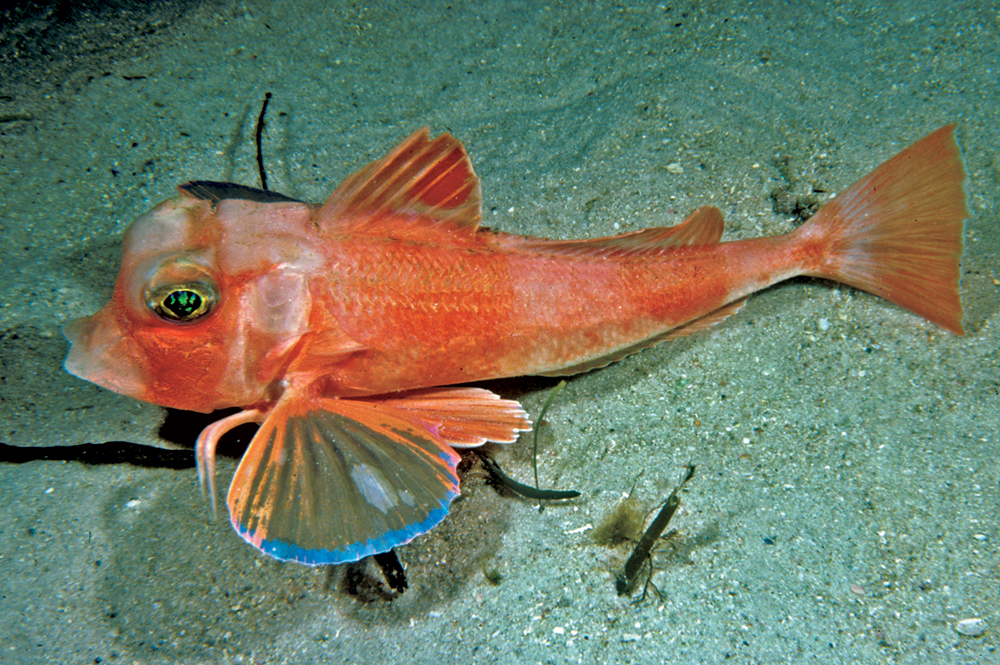Cocky Gurnard, Lepidotrigla modesta Waite 1899
Other Names: Grooved Gurnard, Minor Gurnard, Short-finned Gurnard

Cocky Gurnard, Lepidotrigla modesta. Source: Rudie H. Kuiter / Aquatic Photographics. License: All rights reserved
Summary:
A bright red gurnard becoming whitish below, with a dark red spot on the first dorsal fin, a broad dark red band near margin of the caudal fin, and the inner surface of the pectoral fins greenish with a blue margin.
Cite this page as:
Bray, D.J. 2023, Lepidotrigla modesta in Fishes of Australia, accessed 19 Apr 2024, https://fishesofaustralia.net.au/home/species/3346
Cocky Gurnard, Lepidotrigla modesta Waite 1899
More Info
|
Distribution |
Off Cape Hawke, New South Wales, to Kangaroo Island, South Australia, including Tasmania. Inhabits soft sediment areas in offshore waters. |
|
Features |
Dorsal fin IX + 15-16; Anal fin 16; Caudal fin 11; Pectoral fin 11 + 3; Pelvic fin I,5; Lateral-line scales 58-62. Body of moderate depth (24- 28% SL) and length, thick, tapering posteriorly to slender caudal peduncle. Head small (31-36% SL), but prominent, rectangular in cross section, encased in bone; profile in front of eyes concave, especially in large specimens; eyes large (26-31% HL), interorbital extremely depressed; mouth small (upper jaw length 34-43% HL), horizontal; teeth granular, band in each jaw; small but distinct spines on operculum, above each pectoral fin base and on bony process on each side of dorsal fin origin; a deep groove above and behind each eye, grooves just meeting on top of head; bony rostrum enclosing upper lip with distinct medial notch, each side with several moderately small spines. Scales small, cycloid, weakly attached, covering all of body except chest; lateral line straight, closer to dorsal profile anteriorly than to lateral midline, lateral line scales enlarged with prominent side branches for pores but without prominent spines; scales along bases of both dorsal fins forming a row of enlarged thorn like bucklers. Dorsal fin in two parts, first tall and curved, second elongate and slightly shorter but of more even height; anal fin similar to second dorsal; caudal fin with concave margin, lower lobe slightly longer than upper. Pelvic fins prominent, reaching to or just past origin of anal fin; lower three rays thick and not interconnected by membranes. |
|
Etymology |
The specific name is from the Latin modesta (= moderate, modest, unassuming), possibly in reference to the relatively shorter pectoral fin of this species compared with that of Lepidotrigla mulhalli. |
|
Species Citation |
Lepidotrigla modesta Waite 1899, Mem. Aust. Mus. 4(1): 106, pl. 23. Type locality: off Broughton Island, depth 50-66 fathoms, and off Gibbon, New South Wales. |
|
Author |
Bray, D.J. 2023 |
|
Resources |
Cocky Gurnard, Lepidotrigla modesta Waite 1899
References
Gomon, M.F. 1994. Family Triglidae. pp. 494-505 figs 442-450 in Gomon, M.F., Glover, C.J.M. & Kuiter, R.H. (eds) The Fishes of Australia's South Coast. Adelaide : State Printer 992 pp. 810 figs.
Gomon, M.F. & Last, P.R. 2008. Family Triglidae. pp. 508-514 in Gomon, M.F., Bray, D.J. & Kuiter, R.H. (eds) Fishes of Australia's Southern Coast. Sydney : Reed New Holland 928 pp.
Kuiter, R.H. 1993. Coastal Fishes of South-eastern Australia. Bathurst : Crawford House Press 437 pp.
Kuiter, R.H. 1996. Guide to Sea Fishes of Australia. A comprehensive reference for divers and fishermen. Sydney, NSW, Australia : New Holland Publishers xvii, 434 pp.
May, J.L. & Maxwell, J.G.H. 1986. Field Guide to Trawl Fish from Temperate Waters of Australia. Hobart : CSIRO Division of Marine Research 492 pp.
Neira, F.J., Miskiewicz, A.G. & Trnski, T. 1998. Larvae of temperate Australian fishes: laboratory guide for larval fish identification. University of Western Australia Press. 474 pp.
Richards, W.J. 1992. Comments on the genus Lepidotrigla (Pisces: Triglidae) with descriptions of two new species from the Indian and Pacific oceans. Bulletin of Marine Science 51(1): 45-65. See ref online
Waite, E.R. 1899. Scientific results of the trawling expedition of H.M.C.S. Thetis off the coast of New South Wales. Memoirs of the Australian Museum 4: 1-132 figs 1-10 pls 1-31 https://doi.org/10.3853/j.0067-1967.4.1899.428



